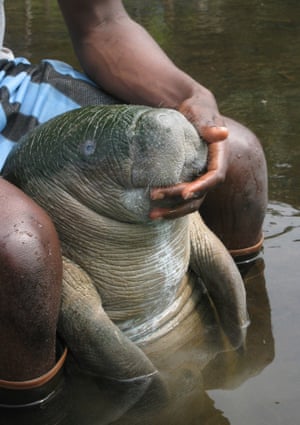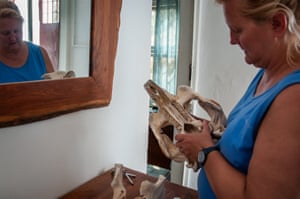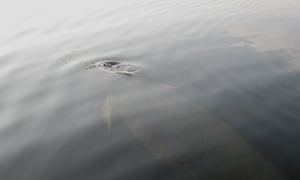It is a blistering day in the Senegalese coastal town of Joal and a group of biologists are standing in a motorised dugout canoe, scanning the cyan waters for floating manatee dung.
Suddenly, a bobbing brown mass appears in the distance.
“Look! Over there! Poo!” cries Lucy Keith-Diagne, the lead researcher. But her excitement is quickly stifled when it turns out to be a piece of wood.
For the past 14 years Keith-Diagne has been on a mission to protect the African manatee. There are an estimated 10,000 left, spread across 21 African countries, from the coast of Senegal down to Angola and inland to Chad. The DNA extracted from faecal samples allows Keith-Diagne to isolate individual populations and determine which groups are most endangered.
African manatees are classified as a vulnerable species on the International Union for Conservation of Nature’s Red List. They face many threats, including entanglement in fishing nets and entrapment in dams. In some countries they are heavily poached.

The animals are so elusive that many locals know them only from myths. In countries such as Senegal, where the animals are revered as auspicious water spirits, poaching is rare. But dams still pose a major threat: the cumbersome mammals can get trapped in narrow passageways and drown.
Keith-Diagne said local dam authorities have been receptive to her proposed modifications of the structures. Politicians have also come on board. In 2014, her husband, Tomas Diagne, also a biologist, successfully petitioned the government to set aside 275 hectares (679 acres) for an aquatic reserve. The area is now home to an estimated 100 manatees as well as hundreds of Adanson’s mud turtles – a species unique to the local lake. The couple are also helping the surrounding communities to develop an ecotourism industry.
Keith-Diagne’s conservation work has extended into other parts of Africa. With the help of a Pew Marine fellowship, she formed a network of nine biologists in Senegal, Gambia, Nigeria, Cameroon and Democratic Republic of Congo to document every manatee captured or killed over three years. The project has already identified one clear trend: Nigeria is a leader in manatee mortality.
Hunters can make up to $2,000 (GBP1,626) from a single catch in the country, where manatee meat is said to be beneficial for diabetics and their oil is thought to be cholesterol-free. In addition, their penises are believed to cure impotence, their ear bones to ward off bullets, and eyes believed to possess magical powers. The faeces left over in manatee intestines are dried and used to mend broken bones.
According to Nigerian myth, upon encountering a human, a manatee will tickle them until they laugh so hard they drown.
Rumours of manatees breaking fishing nets and capsizing canoes led to their classification as a “rogue animal” in the 1970s – an official classification for animals that threaten human livelihoods, such as crocodiles and hippopotami.

The classification was intended as a way for government officials to meet revenue targets, says Edem Eniang, a professor of wildlife resource management at the University of Uyo in Nigeria.
Nigeria began issuing manatee hunting permits but stopped in the early 1990s when hunters began returning empty-handed, demanding refunds. The animals had been driven to the brink of extinction. Now Nigeria has conservation laws that protect manatees and other endangered wildlife, but critics say they are rarely enforced.
“Poachers trade them openly on the street, and nobody does anything,” says Eniang. Last month, Nigeria’s environment ministry announced it was launching an investigation after a video emerged of a manatee being dragged along a road by a group of young men.
The manatee market in Nigeria is so profitable that poachers traffic the animals from neighbouring countries. A growing demand for live manatees in Asia has made matters worse, Eniang adds.
“I’m sitting out here like a lone wolf, crying into the wilderness,” he says. “If we don’t do something now, we’ll end up eating the last manatee.”

In addition to poaching, manatees in Nigeria are suffering from habitat loss. During the dry season farmers graze their cattle on the nutritious wetlands where manatees feed – the climate crisis has left the herders little alternative. As the cattle graze, the farmers set what’s left on fire, hoping it will spur growth.
Oil spills, sand dredging and urban development have also contributed to the destruction of Nigeria’s manatee habitat.
Eniang and his team often go undercover, posing as buyers to keep tabs on poachers and document manatee killings. They visit schools to teach the importance of conservation and they run TV and radio information campaigns. Such campaigns can and have made a difference. In Cameroon, education and awareness initiatives have pushed manatee hunting to its lowest level.
Aristide Takoukam, the director of the African Marine Mammal Conservation Organisation in Cameroon, gives frequent presentations at schools and organises field trips to Lake Ossa, a wildlife reserve created in 1948.
“I want to teach them to see nature in a different way than their parents,” he says. “I want to show them that in animals, they can also find beauty.”
He also trains fishermen in how to make a living from bee farming and soap making instead of manatee hunting and with the help of an American ecotourism expert, is developing an industry around manatee sightseeing, complete with lakeside bungalows, kayaking and bird watching.
“I want to show them that a manatee is worth more alive than dead,” he says.
Though Takoukam has effectively shifted local attitudes toward manatees, another threat has emerged in the waters of Lake Ossa.
Since 2017, the lake has seen a proliferation of salvinia molesta, an invasive plant that kills the antelope grass manatees feed on. The animals have begun migrating into unprotected waters in search of food.

Takoukam suspects that a reservoir dam erected on the Senegal River in 2016 is to blame. The structure flooded vast areas of land, causing plants to decompose and release high levels of nitrogen and phosphorus. When the gates lift, those nutrients are released downstream, ultimately accumulating in the stagnant waters of Lake Ossa. The concentration of phosphorus in the lake has doubled over the past three years.
Takoukam contacted a number of experts asking for help and Louisiana State University answered. They sent him 350 salvinia-eating insects called salvinia weevils, which are currently being reared in a facility near Lake Ossa. As soon as the tick-sized bugs have multiplied they’ll be released onto the lake.
“My manatees were at risk so I needed to find a solution,” Takoukam says.
It is this kind of attitude that inspired Keith-Diagne to organise the first-ever African manatee symposium. The event, planned for April in Senegal, will bring together more than 50 manatee conservationists from at least nine African countries, as well as experts from Florida, Malaysia and Brazil.
It will be the first time activists such as Takoukam and Eniang have a platform to present their work.
“People think nothing is being done to help the African manatee, but actually there’s been a lot of progress,” Keith-Diagne says. “It’s an opportunity to inspire others.”
Find more age of extinction coverage here, and follow biodiversity reporters Phoebe Weston and Patrick Greenfield on Twitter for all the latest news and features